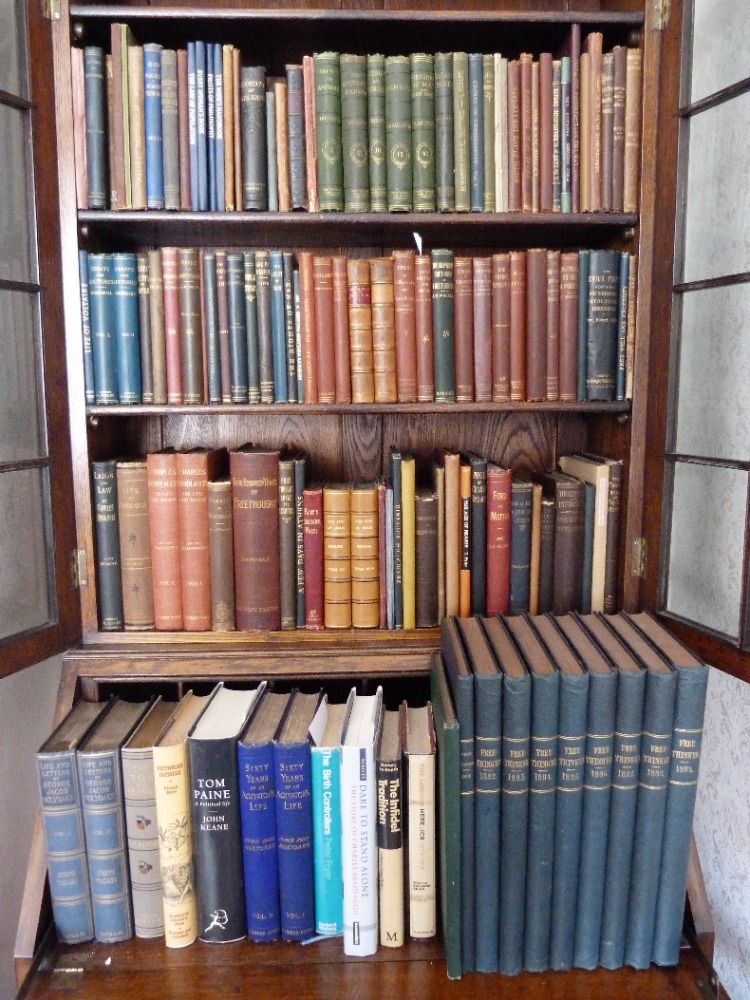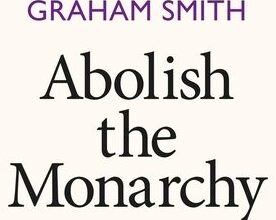Introducing Books From Bob’s Library, a semi-regular series in which freethought book collector and National Secular Society historian Bob Forder delves into his extensive collection and shares stories and photos with readers of the Freethinker. Below, you can find Bob’s introduction to the series and his first instalment, which concerns his copy of Thomas Paine’s freethinking classic The Age of Reason. You can find other instalments here.

Introduction
In common with other members of my family, I love books. Not just their contents (which are, of course, very important) but their appearance, smell, and feel—the older, the better. Their associations with events and people never cease to fascinate me.
My family’s book addiction goes back to my great grandfather, Robert Joseph Forder, who was secretary of the National Secular Society (NSS) throughout most of the heroic Bradlaugh years (1866-90; for more information on Charles Bradlaugh and the history of the NSS, see my video lecture series) and who then became a publisher of freethought literature until he died in 1901. His premises were at 28 Stonecutter Street, which was also the headquarters of the NSS and the birthplace of the Freethinker. In those days, being a freethought publisher carried a high status, following as it did in the heroic footsteps of Daniel Isaac Eaton, Richard Carlile, Henry Hetherington, and James Watson, to name but a few (more on Eaton and Carlile below). I think Robert Joseph’s importance as a publisher of birth control literature is often underrated or ignored.
Robert Joseph’s son, Robert William, became a bookseller and ran bookshops on Charing Cross Road in the interwar years, sometimes aided by his son (and my father), Robert Edwin. After the war, Robert Edwin became a teacher but spent most of his Saturdays at jumble sale book stalls or in second-hand bookshops. He was rarely seen without a book in one hand, and he built up a small but interesting collection of freethought publications. I inherited these when he died, far too young, in 1973.
I became a teacher and, following a chance school staffroom encounter in 1983, I made the acquaintance of Kit Mouat. Kit was a feisty woman, a one-time Freethinker editor and author who was ill and knew she was dying. She had issued freethought book catalogues and persuaded me to take over, selling me her stock. Over the next few years, and until the advent of online bookselling, I issued fifteen catalogues, each with around 400-500 items, and sold thousands of items all over the world. The US was always the largest market. I occasionally look back at the catalogues and blanch when I see the asking price of what are now regarded as antiquarian rarities. It is an unfortunate characteristic of the bibliophile bookseller that each sale brings regret.
My part-time career brought me into contact with many of the leading freethinkers and freethought institutions in the English-speaking world. The most memorable conversations were with Madalyn Murray O’Hair, founder of American Atheists. Madalyn and I had lively telephone exchanges laced with foul language (on her part). At the time she was endeavouring to build up a library and archive in Austin, Texas and was on the hunt for material of the type I was selling. She thought I should offer everything to her first, ahead of other customers. In 1995 I issued a catalogue but heard nothing from Texas. Only later did it transpire that Madalyn with her son and granddaughter had been murdered and their bodies dismembered and hidden. It wasn’t until 2001 that their remains were recovered, with Madalyn being identified by the serial number on her hip prosthesis.
Other memorable acquaintances included Dr Gordon Stein, editor of The American Rationalist and a bibliophile and author, who compiled some important freethought bibliographies along with other works. Gordon had a huge library, now in the hands of the Center for Inquiry in Amherst, New York, which includes many books I sourced. He once visited our home and told me that he had collected every edition of Thomas Paine’s freethinking classic The Age of Reason he could get his hands on, as this was the surest way of identifying every publisher sympathetic to freethought.
Other customers and acquaintances included Jim Herrick, David Tribe, Nigel Sinnott and Bill McIlroy (all former Freethinker editors). I have fond memories of them all.
Knowledge of freethought literature is not common, even among booksellers, and over the next few months, I shall endeavour to share my observations on some of the books, pamphlets, and journals in my collection.
On the purchasing front, I once made a journey to Yorkshire on the strength of a phone call from a vendor of what were once euphemistically called ‘top-shelf magazines’ who had somehow come into possession of some titles containing the word ‘freethought’. He also mentioned some familiar authors’ names to me. It turned out that he had purchased a huge pile of freethought journals, pamphlets, and books, which he had had trouble disposing of—until he contacted me. I will never be entirely clear on how he got hold of the collection, but there was mention of clearing a loft in Stretford, Manchester. We negotiated a price and loaded everything into my Lada Estate (I anxiously watched on as the suspension flattened). There was a complete run of the Freethinker from the first copy in May 1881 until the 1930s, together with a mountain of pamphlets. From some pencil notes and names on the items it became apparent that I had bought the library of the Manchester branch of the NSS.
I found it impossible to part with everything I handled, hence my large and ever-growing freethought library (not good business practice, I grant). In truth, when I started, I did not really understand the significance of many items. Who would have guessed, for example, that The Fruits of Philosophy and The Elements of Social Science are titles of Victorian birth control pamphlets? However, book dealing is a much better educator than it is a wealth generator, which brings me to the purpose of this introduction.
Knowledge of freethought literature is not common, even among booksellers, and over the next few months, I shall endeavour to share my observations on some of the books, pamphlets, and journals in my collection. Some description of what they contain will be essential, but it will also be my aim to explain each publication’s historical significance and the events it was associated with, as well as the importance of the author and sometimes also the publisher.
There is only one place to start: with the freethinking hero Thomas Paine (1737-1809).
The Age of Reason

In a recent Freethinker essay, Eoin Carter credits Thomas Paine with writing three ‘era-defining texts’. The first two were Common Sense (1776) and Rights of Man (two parts, 1791-2). The third was The Age of Reason (three parts, 1794, 1795, and 1807), which dealt with his views on religion. Although these views may have been implicit in earlier works, now they were overt and unambiguously stated, with serious implications for the way posterity was to regard its author. The first part was written under the shadow of the Jacobin Reign of Terror while Paine was living in France, having been driven out of England after the publication of Rights of Man. The Age of Reason represents a shift in his revolutionary focus from the hereditary privilege enjoyed by monarchy and aristocracy to what he saw as the related nonsense and tyranny of revealed religion.
My copy of the first part is dated 1794 and acknowledges the printer as Barrois of Paris, with the seller as D.I. Eaton of the Cock and Swine, 74 Newgate Street, London. Considerable mystery surrounds the first 1793 French edition, of which only one incomplete copy survives. The Joel Barlow edition of February 1794 probably also predates the Eaton version. Further confusion stems from Paine’s frequent early textual revisions, but it was the Eaton edition that sold in large numbers and attracted attention. And what attention it got.
Daniel Isaac Eaton (1753-1814) was one of an extraordinary band of radical, freethinking publishers whose courage still astounds. By the end of 1794 the authorities had already unsuccessfully tried to prosecute him for sedition twice. His premises in Newgate Street (now adjacent to St Paul’s Underground station and in the shadow of the Cathedral) were called the Cock and Swine. This was a provocation in itself: the cock represented French republicanism and the swine was an ironic reference to Edmund Burke’s use of the term ‘swinish multitude’ as a descriptor of the general population in his anti-revolutionary Reflections on the Revolution in France (1790). Eaton also issued halfpenny tokens decorated with images of a cock and swine to be used as currency (see an example here).
Although Eaton avoided imprisonment to begin with, in 1796 he had to flee to America to remain a free man. He returned to England three years later only to have his person and property seized and to be imprisoned for fifteen months. In 1812, he was again imprisoned, this time in Newgate Gaol, which effectively became a university of radicalism with inmates discussing, reading, and even publishing radical works. Part of Eaton’s sentence included his standing in the pillory for an hour a day. This is how his fellow radical William Cobbett described the scene:
‘An immense crowd of people cheered him during the whole hour: some held out biscuits…others held him out glasses of wine, and others little flags of triumph and bunches of flowers. While the executioner and officers of Justice were hooted!’
Cobbett went on to suggest that this backfire led to the end of pillory punishment in London.
Of all Paine’s works, it was The Age of Reason which provoked the most enduring hostility, reaching its apotheosis when Theodore Roosevelt referred to Paine as a ‘filthy little atheist’, all three words of which are inaccurate. As he makes clear at the outset of The Age of Reason, Paine was a deist, not an atheist: ‘I believe in one God, and no more; and I hope for happiness beyond this life.’ Nevertheless, his evisceration of organised religion is absolute. He argued that it was ‘set up to terrify and enslave mankind, and monopolize power and profit.’

And then there is the famous short paragraph which, to my mind, says it all, and gets right to the heart of what freethinking means:
‘I do not believe in the creed professed by the Jewish church, by the Roman church, by the Greek church, by the Turkish church, by the Protestant church, nor by any church that I know of. My own mind is my own church.’ (Emphasis added.)
It is not surprising that The Age of Reason became one of the most prosecuted, if not simply the most prosecuted, works of all time. This repression was successful for a while, and it doubtless reduced the number of copies in circulation. But due to the heroism of a small band of radical publishers, of whom Richard Carlile (1790-1843) is possibly the finest example, it was to become the most famous, or infamous, freethought book ever published. We will hear more about Richard Carlile throughout this series.
There was nothing particularly new about Paine’s criticism of religion. The likes of David Hume and Edward Gibbon had already made their scepticism clear. But they used mannerly language to express themselves and their ideas were politely discussed in fashionable coffeehouses. Paine was groundbreaking in his polemical, militant, witty, and plebian style. Such a lack of deference and respect shook the aristocratic and religious establishment to its core.
For all the reasons mentioned above, The Age of Reason achieved the status of a seminal work in freethought circles. As Chapman Cohen (1868-1954), second editor of the Freethinker, often remarked, the various editions would fill a good-sized room. The Bradlaughite secularists of the late nineteenth century celebrated Paine’s birthday on 29 January each year at the Old Street Hall of Science in what was a kind of freethinkers’ Christmas. Finally, although he never used the term ‘secularism’, the coining of which awaited George Jacob Holyoake (1817-1906), Paine’s conviction that the separation of church and state is a necessary condition for true freedom lies at the very heart of liberal democracy.
Further reading
Image of the week: ‘The world is my country, to do good my religion!’ by Bob Forder
Introducing ‘Paine: A Fantastical Visual Biography’, by Polyp, by Paul Fitzgerald
Freethought and birth control: the untold story of a Victorian book depot, by Bob Forder
Christopher Hitchens and the long afterlife of Thomas Paine, by Daniel James Sharp
‘There is nothing easy or empty about humanity and reason’: in memoriam Jim Herrick (1944–2023), by Bob Forder
From the archive: ‘A House Divided’, by Nigel Sinnott
Image of the week: ‘Wha wants me’, a caricature of Thomas Paine by Isaac Cruikshank (1792), by Daniel James Sharp
The rhythm of Tom Paine’s bones, by Eoin Carter








Your email address will not be published. Comments are subject to our Community Guidelines. Required fields are marked *
Donate